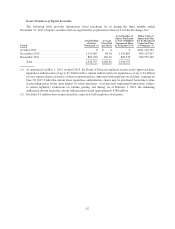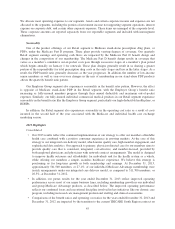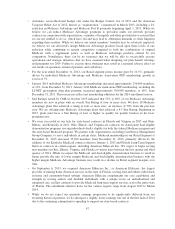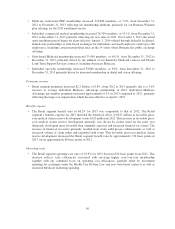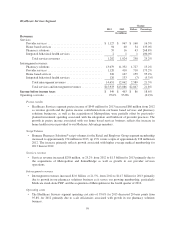Humana 2013 Annual Report Download - page 60
Download and view the complete annual report
Please find page 60 of the 2013 Humana annual report below. You can navigate through the pages in the report by either clicking on the pages listed below, or by using the keyword search tool below to find specific information within the annual report.
being phased-in over two to six years, depending on the level of payment reduction in a county. In
addition, since 2011 the gap in coverage for Medicare Part D prescription drug coverage has been
incrementally closing.
Certain provisions in the Health Care Reform Law tie Medicare Advantage premiums to the
achievement of certain quality performance measures (Star Ratings). Beginning in 2012, Medicare
Advantage plans with an overall Star Rating of three or more stars (out of five) were eligible for a
quality bonus in their basic premium rates. By law, quality bonuses were limited to the few plans that
achieved four or more stars as an overall rating, but CMS, through its demonstration authority,
expanded the quality bonus to three Star plans for a three year period through 2014. Beginning in 2015,
quality bonus amounts will be determined by the provisions in the Health Care Reform Law. In part,
this means that plans must have a Star Rating of four or higher to qualify for bonus money. Star
Ratings issued by CMS in October 2013 indicated that 55% to 60% of our Medicare Advantage
members are now in plans that will qualify for quality bonus payments in 2015, down from 99% in
2014, primarily due to an increase in the minimum overall Star program rating from three stars in 2014
to four stars in 2015. Beginning in 2015, plans must have a Star Rating of four or higher to qualify for
quality bonuses in the basic premium rates. We have 18 Medicare Advantage plans that achieved a
rating of four or more stars, an increase of 50% from the previous year. We are offering nine Medicare
Advantage plans that achieved a 4.5 Star Rating. Plans that earn an overall Star Rating of five continue
to be eligible to enroll members year round. Notwithstanding successful historical efforts to improve
our Star Ratings and other quality measures, there can be no assurances that we will be successful in
maintaining or improving our Star Ratings in future years. Additionally, as a result of the expiration of
the quality bonus demonstration, for plans that maintain a four Star or higher rating in 2015, other
provisions of the Health Care Reform Law may, in certain areas of the country, reduce the amount of
the quality bonus that is added to the basic premium rate. Accordingly, our plans may not be eligible
for full level quality bonuses, which, in isolation, could adversely affect the benefits such plans can
offer, reduce membership, and/or reduce profit margins.
In addition, on October 1, 2013, the initial open enrollment period began for plans effective January 1,
2014 offered through federally facilitated, federal-state partnerships or state-based exchanges for
individuals and small employers (with up to 100 employees), including certain metropolitan areas in
the 14 states where we have public exchange offerings. In addition, federal and state regulatory
changes in December 2013 extended the enrollment deadline for January 1, 2014 insurance coverage
from December 15, 2013 to December 24, 2013, required plans to accept payment for policies with a
start date of January 1, 2014 as late as December 31, 2013 (we voluntarily extended our deadline for
payment to January 31, 2014 and voluntarily extended our deadline for payment to February 28, 2014
for policies with a start date of February 1), and allowed certain individuals to remain in their existing
underwritten off-exchange health plans that are not compliant with the Health Care Reform Law. The
initial enrollment period continues through March 31, 2014. See “Risk Factors” in this report.
•Newly Effective in 2014: Beginning in 2014, the Health Care Reform Law requires: all individual and
group health plans to guarantee issuance and renew coverage without pre-existing condition exclusions
or health-status rating adjustments; the elimination of annual limits on coverage on certain benefits; the
establishment of federally facilitated, federal-state partnerships or state-based exchanges for
individuals and small employers (with up to 100 employees) coupled with programs designed to spread
risk among insurers; the introduction of plan designs based on set actuarial values; the establishment of
a minimum benefit ratio of 85% for Medicare Advantage plans; and insurance industry assessments,
including an annual health insurance industry fee and a three-year $25 billion industry wide
commercial reinsurance fee. The annual health insurance industry fee levied on the insurance industry
is $8 billion in 2014 with increasing annual amounts thereafter, growing to $14 billion by 2017, and is
not deductible for income tax purposes, which will significantly increase our effective income tax rate
in 2014 to approximately 45% to 47%. The NAIC is continuing discussions regarding the statutory
accounting for the health insurance industry fee which in its present form would restrict surplus in the
50




